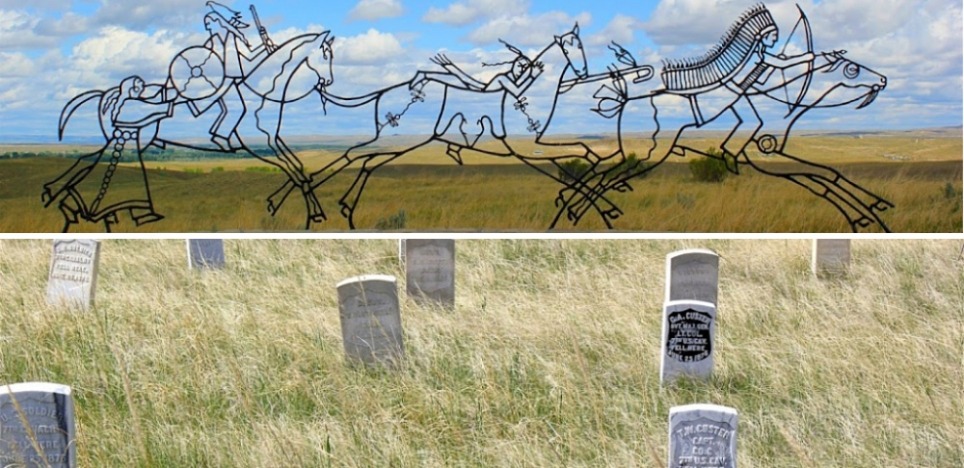The Battle of Little Bighorn, known to the Lakota and other Plains Indians as the Battle of the Greasy Grass, and also known as Custer's Last Stand, was fought on this day in 1876. In a Montana valley, General George Custer and some 200 men in his Army battalion were attacked by as many as 3,000 Native Americans, mostly Sioux and Cheyenne. Within an hour, Custer and all his soldiers were dead.
One of the Native American leaders of the attack was Crazy Horse, an Oglala Sioux. He had a vision which convinced him that he was destined to protect his people from the encroaching white men who had slaughtered the buffalo and now were trying to take over tribal lands in their quest for gold. The other leader was Sitting Bull, a sagacious Teton Dakota chief who had seen too many treaties broken and objected to new government orders that the tribes give up their nomadic way of life and move to reservations.
Custer, on the other hand, was a great believer in Manifest Destiny, the the doctrine that the white man was destined to expand his influence and land ownership throughout the American continent. He and his superiors took the position that the Native Americans would have to be relocated from key areas or exterminated.
The Battle of Little Bighorn, although at first seen as an Indian victory, had a longer-term consequence. The white public was outraged at the death of Custer, a popular figure, and the government increased its efforts to move the tribes. In The Fatal Environment: The Myth of the Frontier in the Age of Industrialization, 1800 – 1890, Richard Slotkin concludes that for many Americans Custer was triumphant even in defeat: "The optimistic reading emphasized the sacrificial aspect of the battle, showing that Custer's death struggle wounded the Indians and aroused the slumbering spirit of the American nation, leading in the end to revenge on the Indian and the triumph of a chastened and purified people."
Within two years both Crazy Horse and Sitting Bull would be dead, killed by white men. Within five years, almost of the Sioux and Cheyenne would be confined to reservations.
 Quotes
Quotes
Custer Died for Your Sins: An Indian Manifesto is a 1969 nonfiction book by Native American author, theologian, historian, and activist Vine Deloria, Jr. The book questions how U.S. government agencies, churches, anthropologists, and others have approached issues affecting Native Americans. As you remember what happened at Little Bighorn, reflect upon these quotes from Deloria's book:
"Until America begins to build a moral record in her dealings with the Indian people she should not try to fool the rest of the world about her intentions on other continents. America has always been a militarily imperialistic world power eagerly grasping for economic control over weaker nations."
"When asked by an anthropologist what the Indians called America before the white men came, an Indian said simply 'Ours.' "
 Art
Art
Artists have given Little Bighorn more attention than the Civil War's Battle of Gettysburg. Evan Connell, author of Son of the Morning Star, ranks Custer's Last Stand alongside Napoleon's retreat from Moscow, Hannibal's crossing of the Alps, and the Charge of the Light Brigade during the Crimean War. You can find a sampling of paintings of Custer, Crazy Horse, and the battle here. In what different ways is the event depicted? What feelings are evoked in you by the paintings? You might make your own painting or drawing to reflect your view of this historical event.
 Films
Films
The movie Little Big Man, directed by Arthur Penn based on Thomas Berger's rough-and-tumble 1964 novel, is both a tall tale and a meditation on the white man's western expansion. Dustin Hoffman plays Jack Crabb, the sole white survivor of the Battle of Little Bighorn. The humorous treatment of Indian society and the serious treatment of the military tend to balance out in the tragicomedy of history. As a result, the movie can be seen as an attempt to assimilate the contradictions of history — one of the chief aims of comic art. Watch the film, keeping in mind Penn's comment on his approach:
"The film is oddly comic and maybe that's not the appropriate way to deal with something as important and as meaningful as this, but on the other hand maybe it is the way. Maybe one approach is to go by a more opaque way than saying this is a direct representation of what went on."
Son of a Morning Star, a four-hour television miniseries, was originally presented on ABC in 1991; it was based on the acclaimed bestseller of the same name by Evan S. Connell. It traces the events of the Plains Indian Wars leading up to the Battle of Little Bighorn and recreates that pivotal battle. To tell the story, the filmmakers used an unusual device. Voice-over narration provides two perspectives on the unfolding drama: that of Libbie Custer, the General's devoted wife, and that of Kate Bighead, a Cheyenne woman, who presents the American Indian account of the events.
Get together with some friends and brainstorm how you would tell the story of Little Bighorn. Which players would you emphasize? Would it be a story of triumph or defeat?
